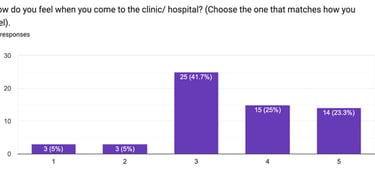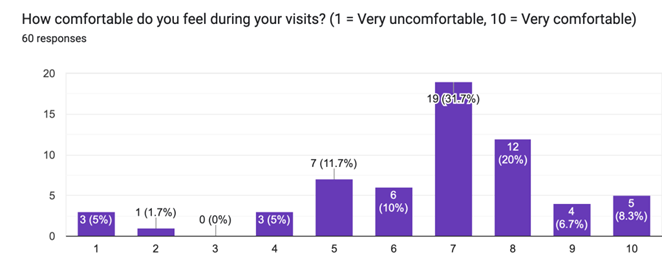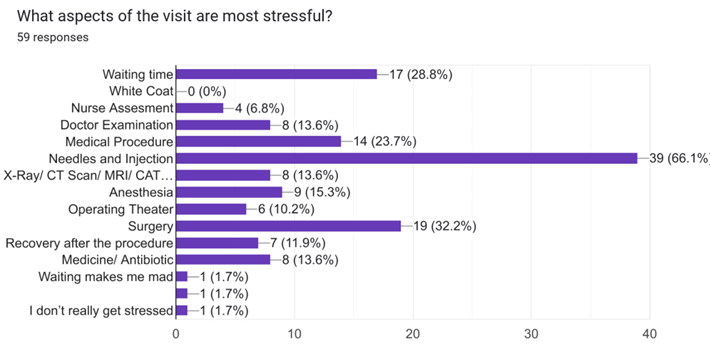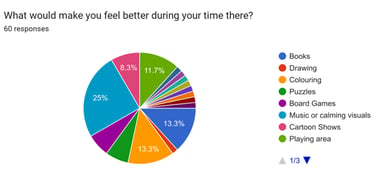Enhancing Pediatric Care: Research and Innovations to Reduce Stress and Improve Well-being
Zaineb Zouaoui
Introduction
Millions of children around the world face the burden of increased stress and anxiety in a clinical environment. This added cortisol can deeply hinder their speed of recovery and possibly add to their illnesses. Current research provides us with a general blueprint, however, it isn't a one-size-fits-all solution. This study focuses on gaining real feedback from patients on their personal experiences, allowing us to answer questions such as, to what extent does reducing the stress level in pediatric patients speed up recovery? And, what are the most effective strategies for enhancing the hospital experience of pediatric patients?
Results


Figure 1- (Rating 1-5) How children feel when visiting a clinical setting
When asked “How do you feel when you come to the clinic/ hospital?” the average rating was 3.44, we can tell that patients feel slightly uncomfortable or scared in a medical setting. After consulting with an expert I found that, according to the shape of the graph, we can see that there is a normal skewness telling us that the results are expected and there is a normal distribution.
Method
A 9-question survey was sent out to the parents of a variety of children. Due to the fact that children are considered vulnerable groups, according to the United Nations, it’s recommended that parents answer on the child's behalf. Children's ages ranged from 3 to 18 with responses showing most patients visited a healthcare facility 1 to 3 times per year. The results were collected in 2 different ways. Initially, the survey was sent out to students in our school and other children in our neighbourhood. Next, to expand and diversify this range I volunteered at a thalassemia center for one day, and provided these long-term patients with a digital form to answer. To reduce the risk of potential biases, all the responses were analyzed to ensure no anomalous results. This survey, unlike other methods, allowed us to efficiently collect valuable information for this study, by optimizing the questions given, in order to maximize the result for data analysis. It provides us with the ability to reach a larger group and collect both qualitative and quantitative data to formulate a detailed conclusion. To further back up the results I interviewed 2 different doctors (both from different fields- family medicine and immunology) to gain more insight into this topic from the scientific perspective.


Moreover, in question 6 the survey takers were asked “How comfortable do you feel during your visits? (1 = Very uncomfortable, 10 = Very comfortable)”. To which the majority answered 7. There is some concern over this number as science shows it is most often the chosen number (when asked to choose from 1-10) The shape of the graph portrays a negative skewness (leaning towards the left) and the data points are more concentrated towards the right-hand side of the distribution.
Figure 2 - Scale 1-10 rating of how comfortable children feel during their visits


Figure 3 - Graph representation of a multiple choice question (What is the scariest in a medical setting)
Next, I created checkbox questions allowing the child’s parent to choose what the most stressful part of the visit was. With an idea of how comfortable they felt, I was eager to understand why in order to indirectly create a solution/ conclusion. 39 out of the 60 of the pediatric patients believed the most stressful part was having to take a needle and injection. The following responses include the fear of surgery as well as medical procedures and finally the waiting time. This phenomenon can also be explained by General Practioner Dr. Asma Kossentini and Immunologist Dr Maryem Rabah. During an interview with them, I found that from their experience the unfamiliar environment and fear of the unknown (what is going to happen next) caused lots of stress and anxiety in
children. This explains why medical procedures and waiting time are among the top responses for causing higher stress levels.


Now that I have had a general understanding of how pediatric patients feel in these environments I decided to ask them what they would like to add to make their experience less stressful/scary and more comfortable. 25.4% of the survey takers feel that the best way to reduce stress is to implement music and calming visuals in a clinical setting. The runner-up response includes; books, a playing area, colouring and cartoon shows. This allowed me to shape my product to fit the audience and appeal to what helps the majority. So, I came up with the idea of creating a VR or MR headset (previously used by abbot for blood donors)
Figure 4 - Pie Chart representing improvements that patients believe would reduce stress in a clinical setting
To what extent does reducing the stress level in pediatric patients speed up recovery?
After careful consideration and research utilizing a variety of different sources both primary and secondary, I believe I now have sufficient information, knowledge and understanding on the topic to accurately answer the questions, providing examples and correct scientific reasoning.
Firstly, pediatric patients tend to feel higher levels of anxiety and stress when put in a clinical setting. This statement remains true for both long-term and short-term patients. This is due to various factors such as needles and injects, waiting time, medical procedures, surgery, doctor and nurses examinations and more. The fear of not knowing what is coming next coupled with the lack of control children have in this scenario deeply affects their well-being. According to doctors and experts in the field, a quick interview shows that added stress can weaken the immune system. It stimulates hormones like cortisol which could delay wound healing and increase inflammatory response. Other sources also show that long-term hospitalization can lead to isolation, anxiety, helplessness, and hopelessness, which can be extremely harmful to a child. Therefore, with all of this in mind, I can confidently say that reducing stress for children in a medical setting improves and speeds up recovery time to a great extent. Lower cortisol levels improve wound healing and a more calming environment creates hope for the patients.
What are the most effective strategies for enhancing the hospital experience of pediatric patients?
After careful analysis of various sources, I have compiled a list of a few of the most effective strategies used by healthcare workers and developed by research for tackling the issue of increasing stress for pediatric patients in clinical settings and the effect it has on their recovery.
Many sources have discussed the importance of integrating control and trust within a child's patients during medical examinations because it is one of the causes of rising stress levels in a medical environment. According to the questionnaire I sent out to patients, children believe the best way for them to reduce stress in a clinical setting is to deploy more calming visuals and music. This can be done in various ways. From decorating the hospital wall to playing soothing music in the eating area, or even implementing virtual reality or mixed reality headsets. According to Abbot, it has been used in the USA to increase the number of people donating blood and allow them to feel more comfortable by promoting a safe space. Another effective strategy backed up by researchers at the University of Oxford, UK, shows us the importance of play in a clinical environment. Play is essential for a child and imperative to ensure growth. Play teaches a child lots, whether they play alone or with other children. Currently, there is even the upcoming development of playing specifics to ensure the child benefits the most out of this experience. This can be done by various means. A researcher found that after surveying child patients found that art play is one of the most satisfying and effective strategies in alleviating stress and anxiety. It provides control and allows the child to express themself in forms other than words. Sensory play is also extremely beneficial. By exposing the child to different textures to allows they’re body to automatically be open to new sensations. However, it is crucial to remember that, not all techniques work for everyone. The implementation of the different methods and strategies is imperative to ensure every child feels safe and comfortable.
Works Cited:
Interviews:
Rabah, Maryem. Interview. Conducted by Zainb Zouaoui. 30 Dec 2024
Kosssentini, Asma. Interview. Conducted by Zainb Zouaoui. 30 Dec 2024
Elloumi, Ikbal. Interview. Conducted by Zainb Zouaoui. 8 Dec 2024
Journal Articles
Lerwick, J. L. (2016). Minimizing pediatric healthcare-induced anxiety and trauma. World Journal of Clinical Pediatrics, 5(2), 143-150. https://doi.org/10.5409/wjcp.v5.i2.143
Isokääntä, S., et al. (2019). Resilience in children and their parents enduring pediatric medical traumatic stress. Paediatric Anaesthesia, 29(3), 218-225. https://doi.org/10.1111/pan.13573
Greenfield, G., et al. (2021). Characteristics of frequently attending children in hospital emergency departments: A systematic review. BMJ Open, 11(10), e051409. https://doi.org/10.1136/bmjopen-2021-051409
Smith, M. L. (2015). Interventions to minimize distress during pediatric primary care visits: A systematic literature review. BYU ScholarsArchive. https://scholarsarchive.byu.edu/studentpub/4/
Chiang, C.-Y., et al. (2023). [Title in English]. The Journal of Nursing, 70(3), 19-25. https://doi.org/10.6224/JN.202306_70(3).04
Rokach, A., & Matalon, R. (2007). 'Tails' - A fairy tale on furry tails: A 15-year theatre experience for hospitalized children created by health professionals. Paediatrics & Child Health, 12(4), 301-304. https://doi.org/10.1093/pch/12.4.301
Silveira, K. A., et al. (2019). Stress related to pediatric hospitalization and possible interventions: An analysis of the Brazilian literature. Temas Em Psicologia, 27(2), 443-458. https://doi.org/10.9788/tp2019.2-11
Mîndru, D. E., et al. (2016). STRESS in pediatric patients—the effect of prolonged hospitalization. ResearchGate. https://www.researchgate.net/publication/317778983_STRESS_IN_PEDIATRIC_PATIENTS--THE_EFFECT_OF_PROLONGED_HOSPITALIZATION
Gouin, J.-P., & Kiecolt-Glaser, J. K. (2011). The impact of psychological stress on wound healing: Methods and mechanisms. Immunology and Allergy Clinics of North America, 31(1), 81-93. https://doi.org/10.1016/j.iac.2010.09.010
Gee, D. G., & Casey, B. J. (2015). The impact of developmental timing for stress and recovery. Neurobiology of Stress, 1, 184-194. https://doi.org/10.1016/j.ynstr.2015.02.001
Websites
Play Specialist Team. (2024). Children’s play in hospital: Information for parents and carers. Oxford University Hospitals NHS Foundation Trust. https://www.ouh.nhs.uk/patient-guide/leaflets/files/72022play.pdf
Mayo Clinic Health System. (2022, June 2). Stressed-out kids? Signs and strategies. Mayo Clinic Health System. https://www.mayoclinichealthsystem.org/hometown-health/speaking-of-health/stressed-out-kids
Flavin, B. (2018, February 20). 14 types of healthcare facilities where medical professionals provide care. Rasmussen University. https://www.rasmussen.edu/degrees/health-sciences/blog/types-of-healthcare-facilities/
Abbott. (2023, June 14). Taking blood donation to a new dimension of reality. Abbott.com. https://www.abbott.com/corpnewsroom/diagnostics-testing/taking-blood-donation-to-a-new-dimension-of-reality.html
Gebauer. (n.d.). How you can improve pediatric patient comfort. https://www.gebauer.com/hubfs/docs/Ebooks/Pediatric_Patient_Comfort_eBook.pdf
Encyclopedia Britannica. (2021). Explore milestones in human brain development. https://www.britannica.com/video/Curious-learners-milestones-brain-development-cognitive-growth/-255382
SphereGen. (2023, May 29). Mixed reality headsets. SphereGen. https://www.spheregen.com/mixed-reality-headsets/
yigitbaba. (2023, April 22). What is a mixed reality headset?. Capsulesight.com. https://capsulesight.com/mixedreality/what-is-mixed-reality-headset/
yigitbaba. (2023, April 16). 15 examples of the use of mixed reality in healthcare. Capsulesight.com. https://capsulesight.com/mixedreality/15-examples-of-the-use-of-mixed-reality-in-healthcare/
Lang, B. (2014, October 17). ‘Guided Meditation’ proves that ‘VR relaxation’ will almost certainly become its own genre. Road to VR. https://www.roadtovr.com/guided-meditation-proves-vr-relaxation-will-almost-certainly-genre/
Videos
YouTube. (2025). [360° VR Spacewalk Experience | BBC HOME]. https://www.youtube.com/watch?v=hEdzv7D4CbQ
YouTube. (2025). [360° VR Forest Walk - 8K Virtual Relaxation with Soothing Forest Sounds & Bird Song - Part #1]. https://www.youtube.com/watch?v=G_gmoSejUxU
YouTube. (2025). [Minecraft 360° VR Extreme Roller Coaster Ride Will Trick You]. https://www.youtube.com/watch?v=Dk96JTfpSYc
YouTube. (2025). [Beautiful Forest Wildlife in VR180 🦌 Deer & Elk - Relaxing VR Experience, Oculus, Apple Vision Pro]. https://www.youtube.com/watch?v=74F6lAOLtyA
